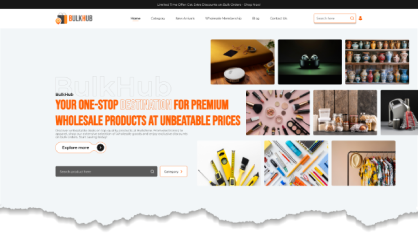
Introduction
Have you ever thought multiple businesses could be unified in a single store? Well, this is only possible with WordPress. Want to know how? Let’s get started.
WordPress and Woocommerce have a special and exclusive way to manage and set up multiple stores in a unified place. This is where the concept of multi-site occurred. Now, owners with numerous ventures can secure their websites in a single store. There is no need to put extra effort into designing a website for every store; a single site is there. A single website can have Woocommerce multiple stores with different categories and products. And let me tell you, you don’t need to have various Woocommerce installations or numerous dashboards. It provides a unified place where everything can be managed easily. So, let's initiate grabbing more of it.
What is Woocommerce Multiple Stores Functionality?
Woocommerce, with its wonderful creation, has now grown up to support multi-store features. This feature allows you to create multiple online stores owned under a single Woocommerce platform and database. This is the simplest way if you have multiple businesses and are looking to manage them with ease.
Giving an example, you own a supermarket where multiple items are sold from various categories. So, various item categories are online stores, and all are managed under you. You play the role of a woocommerce platform where everything is managed. You cannot own different platforms for every single type of category to manage. This can be a bit crucial and capital-consuming. However, Woocommerce makes it much easier for you to manage under a single platform. This is nothing but the multi-store functionality.
How does Woocommerce Multiple Stores Functionality Work in Woocommerce and WordPress?
Having your foot in diverse industries and managing them can lead to a bigger state of confusion. However, Woocommerce allows you to manage and set up multiple stores under a single platform. This becomes the most powerful and aligned way to manage multiple stores effectively. But there are other things about multi-store functionality; you need to know how this works. Here are some key points to know when you are setting up a Woocommerce multi-store.
1. Single Woocommerce Installation
Yes, you heard it right. You need a single WooCommerce installation, and that’s what truly makes it beautiful. A single Woocommerce installation can handle multiple stores serving as a foundation with less effort. This serves as a centralized hub for maintenance and updates, along with a single codebase to handle.
2. A Shared Database
Although there is a single Woocommerce installation for multiple stores, they have a shared database. This shared database works for every store you have in a single Woocommerce installation. It works like a library, where every type of store has a separate shelf or shared server space. From there, all the management and retrieval of stores are managed efficiently.
3. Separate Stores with Unique Domains
Your Woocommerce multiple stores website with multiple stores owns its unique identity along with its unique domains. Every store is independent on its own and shares unique domains and subdomains. This in turn gives complete flexibility to each store and makes it easy to manage the market insights.
4. Theme and Plugin Flexibility
Unlike the domains and servers, you can have a separate selection for best WordPress themes and plugins. This means you can either choose a single theme for all the stores or simply own separate themes for every store. What this turns out is the brand consistency; you can flexibly maintain individual standards for every store or the entire website.
5. Tailored Product and Inventory Management
As said, every store is individually destined and distinctive; eventually, the products and inventory will be different. Each store owns its products, categories, pricing, and more. This helps in managing every store in a granular manner and keeping the market needs up to the mark.
Is Multi-Store Functionality a Good Idea?
When going for a multi-site setup to manage multiple stores, you often come across whether to set it or not. Going for multiple Woocommerce installations and various domains makes sense to most of the users. I know, but have you flipped the coin on the other side? I’ll help you make the right decision. Is multi-store functionality a good idea or not?
1. Centralized and Simpler Management
When you go with a single Woocommerce installation for every store of yours, there comes a centralized management for all. Which makes it simpler to manage every store from a single dashboard along with faster updates. You can manage the inventory along with the themes and plugins from a single dashboard. It eventually aligns the workflow to fast and effective sides rather than visiting every single store. Most importantly, there will be backups made centralized for every store, making your tasks just simpler.
2. Cost Savings Due to Shared Resources
It seems you save a lot when you opt for a Woocommerce multiple stores setup, as you save in codebase and database costs. Eventually, hosting services aren’t required in more numbers when you have multiple sites. This is the biggest advantage, as more of the resources are saved when you cut costs but invest in a unified architecture.
3. Consistent Branding and Uniform Design
When it comes to branding, you look for a boosted user experience that spills back on your business. And when you have a multi-site, you can manage a consistent branding environment for every store you own. But this applies when you opt for a single theme across the entire site, covering every store. This ensures a unified branding, giving users a perfect user experience and maintaining the design and branding.
4. Cross-Promotion and Cross-Selling Opportunities
When you place multiple stores under a multi-site, you are opening doors to more opportunities and collaborations. This is where you can create strategies for cross-promotions and cross-selling. Encouraging users to another store can be easily done using promotions. You can even promote your stores through upselling and cross-selling, pushing more sales and revenue.
5. Centralized User Management
A multi-site comes with a single dashboard, managing every store equally. That means user management becomes eventually simpler with no complexity to deal with. It owns centralized accounts for both customers and the owners. Managing user roles becomes significant and boosts experience. Users can seamlessly manage multiple stores without using multiple logins.
6. Easy Scaling for Business Growth
Setting up a Woocommerce multiple stores comes with bigger and more exploring opportunities for your business. You must have dreamt of scaling up your business into multiples, and this multi-store feature is a true key. With this, you can easily set up sub-stores within the existing network. No technical or extra hassle is required when you opt for your store expansion.
Even with its centralized user management system, you can easily expand your business with a supportive future system.
Challenges Occurring in Managing Multiple Stores
When you know there are a lot of benefits to count on while setting up a Woocommerce multi store, there may be some consequences too. Let’s hear it out.
1. Complexity in Management and Configuration
Challenges are ongoing when you are getting so many benefits for a multi-site. Firstly, the biggest challenge is the configuration complexity. Configuring or building a multi-site store can be a bit daunting. Unless you have an expert developer, you can’t move ahead with the installation process. It requires more than the basic knowledge about WordPress and Woocommerce, which beginners can’t do.
2. Plugin Compatibility Issues
Plugins play well when it comes to optimizing any website or keeping it safe to the most extent. But let me make this clear to you: not every plugin seems generous and safe for Woocommerce multiple stores ground. Some are crucial to understand, while some of them may create issues or conflicts between the safer side of your store.
While it becomes crucial to test all of them, you need to make sure they do not affect the entire aura of the multi-site. Make sure that the plugins are compatible with multiple sites, and those with single sites require additional services.
3. Limited Isolation and Security Concerns
A multi-store setup comes with a lot of benefits to count on. Each shop has an independently defined and raised in terms of products and accessibility. Even the database and the site platform are unified, giving centralized management and configuration. However, this centralized management can cause a state of vulnerability for others even if a single store is harmed. Security breaches are more seen when all the stores are clubbed with a centralized dashboard, updates, and other features.
4. Customization Challenges
Customizing a multi-store is itself a huge challenge, as all the stores share a common database and a codebase. Giving perfect customization to each store without affecting the others can be a challenge. It needs to have an expert approach or intricate codebase to do so.
5. Hosting Requirements
Your Woocommerce multiple stores website is a junction to so many stores on a single Woocommerce installation. This is not a limited place; you can grow stores as the demand, value, and traffic increase. Since all your stores occupy a single server, the server demands and the services can escalate eventually.
To avoid such vulnerabilities, it is better to opt for a powerful hosting provider that is capable of handling such increased resources. It even depends upon perfect planning and structuring of all the stores on your site and does not affect each other.
How to Create a Woocommerce Multiple Stores Network?
So, finally, we are heading to form a Woocommerce multi-store network. This isn’t a crucial task but requires perfect planning and implementation. And with this guide, we will make sure to cover every aspect that helps in perfect design. Before initiating any step, here are some of the checkpoints you must notice before the creation.
- Make sure that the hosting service you have chosen is compatible with multiple website setups.
- To create a multi-site network, you should be the admin of the live WordPress installation.
- You must be able to access the server’s files using an FTP client or file manager.
- Keep proper management and decide whether you have to use subdomains or subfolders for multiple websites.
- Keep in mind that your multi-site will have a shared database with individual directories for media uploads and separate tables for the database.
- Keep in mind that the themes and plugin installation are different when you set up multi-site. If you are activating any theme or plugin on a single store, it will be activated on all stores.
Step 1: Back up your Current WordPress Website.
The first step tells you to keep a backup of all the existing files as your existing WordPress installation will be updated. You must keep a backup to avoid data loss. Also, deactivate all the plugins and make sure that the permalinks are functioning well.
Step 2: Enable Multi-Site in the WordPress wp-config.php file.
The next step asks you to add a codebase in the wp-config.php file to enable the multi-site network menu in the dashboard. For this, you need to paste the below line of code in the wp-config.php file:
/* Multisite */
define( 'WP_ALLOW_MULTISITE', true);
After pasting this code, refresh your page.
Step 3: Create a Multi-Site Network
The next step is to create a Woocommerce multiple stores network, and you need to visit the Tools section under the WordPress dashboard. Then tap Network Setup and kindly follow all the prompts in it. Now, you must choose between subdomains and subdirectories according to your needs. After this, fill in all the vital details related to the server address, network, and email. Review all the details and then tap the Install button. Lastly, you need to follow the instructions after installing the network.
Step 4: Admin Settings
On the admin panel, you will now see the My Sites icon on the top bar, which will list all your sites along with Network Admin. You can then visit the network dashboard and manage the network settings.
Step 5: Install and Configure WooCommerce
The next step is to install Woocommerce and configure its settings.
- For this, visit the My Sites icon and then the Network Admin option. Then, under the Plugins option, tap Add New.
- If you see Woocommerce on the top suggestions, then hit the Install button and then activate it.
- If you can’t see woocommerce in the top suggestions, simply search and install.
- Note that WooCommerce will be installed on all individual sites, but you need to activate it on every site.
- After this, you can configure the site settings of each store one by one. To access the sites, tap Sites and then the All Sites option.
Also, you can create a new site by tapping the Add New button at the top. Now you need to add all the relevant details, including the site name, URL, and admin email. For this, you need to keep in mind that if you have used sub-domains, you will have to make relevant changes. You need to point out those sub-domains to the WP installation using the DNS registrar.
If you want to configure individual store settings, you need to visit the individual store’s dashboard, then Woocommerce, and then tap Settings.
You can easily configure the store details in the General tab. Also, there are tabs with products, shipments, payments, and more to conquer. You need to set up features for every store, as every store has its specific functionalities.
Step 6: Manage User Roles and Permissions Across the Network
Here’s the next step where you need to create various user roles giving access to all site networks. For this, you need to visit the Network Admin area under My Sites. Then under the Dashboard, reach All Users under the Users tab. Here, by filling in the details of a new user, you can create a new user profile.
Note this: for every store, there is a separate checkout page or payment settings, which can be complicated to handle. It is advised to set a common checkout page for all the stores, which is highly beneficial for vendors and customers.
Some Most Useful Woocommerce Multiple Stores Themes and Plugins
When building a multi-store network, themes and plugins make it much easier to conquer the best functionality. Although WordPress is itself a self-functioning community with potent features, themes, and plugins make it smoother.
Plugins range up your website’s functionality 2X times more than usual. But you need to take a deep thought into when you should use plugins on your multi-store site.
As known, WordPress never ranges down when it comes to functionality or feature counts. But a time comes when you feel that the functionality or the management should be smarter than usual. You wish to gain streamlined organization and a better user experience for your site.
A multi-store creation comes with a lot of complexities that need to be hinged with the right plugins. Here, plugins can ease the functionalities in no time.
Plugins are the ultimate handles for delivering a boosted user experience in terms of checkouts, payments, and more. Also, these are the keys to the consistent functionality of websites with multiple stores in them.
To meet the standard specifications of every store, you wish for customizations that make every store unique on its own. Plugins make it much easier when your store needs a tailored and creative appearance.
Here is the best Woocommerce multiple stores plugins from WordPress:
1. WooMultiStore

Designed to embrace multiple stores or a multi-site, this WooMultiStore plugin is a must-have. The plugin has a superb design gripped with professional inventory, product, and store management skills to offer. This single plugin comes with a lot of transforming features like stock management, synchronization, metadata-export, and more. Also, it offers coupon strategies across all the stores along with their syncing features.
2. Woocommerce Product Add-ons

Presenting a wonderful plugin formed by the VW Themes adding more complex features to your Woocommerce site. Woocommerce pages aren’t enough sometimes to get your desire done the right way you have thought. But with the Woocommerce Product Add-ons, it is possible to get your thing well on your store. This plugin is perfectly designed to address single Woocommerce stores or multi-sites. From customization to layout designs, the plugin offers a great range of features that lift your store. Additionally, the plugin can be integrated with other Woocommerce extensions too.
Multivendor Marketplace WordPress Theme

This is the Multivendor Marketplace Wordpress theme by VW Themes brought up to design multi-vendor online stores. The theme is designed to give a unified space for multiple vendors and their Woocommerce multiple stores. This theme holds a spacious and highly intuitive interface that comes with a lot of features to capture. It is designed using modern designs with colourful and eye-catching layouts to cater. Its responsive interface lets your site work across every screen size without any clutter. Also, it is fully customisable, ready for search engines, and can be connected with multiple plugins.
How to Optimize a Multi-Store Environment?
You have your multi-store ready with you, and now it's time to get its optimization done to make it more efficient. When you optimize your store, it becomes secure and performs well even if certain changes are applied. So, here are some of the optimizing tips you must know about your multi-store.
- Make sure your product catalogues are organized and updated well across all the stores. For this, built-in Woocommerce tools like import-export help in maintaining consistency and make it convenient to work.
- You must define the right user roles on your multi-store so that it does not harm the security. Defining the right user roles helps ensure that only the right individuals are getting access to the website.
- Also, you need to create the right customization strategy that lets your site define which elements should be tailored to your site.
- Keep your website data backed up so that it regularly saves and can be used anytime. Your Woocommerce multiple stores has a shared database, which can cause data breaches, and then you can use the backed-up data.
- You must keep track of your store’s performance analysis so that you know how your site is working.
Best Practices for Marketing and SEO
Your store must be well-informed about the best marketing and SEO practices that lead to successive grades on the web. Here are some of the best marketing and SEO practices you must apply:
- For your multi-store, you must use a unified email marketing platform that helps in consistent marketing across all the stores. With this, you can send automated emails to shoppers according to their views on your site.
- You can use inventory management plugins offering inventory management features. They help in synchronizing inventory in terms of availability and stock levels and automatically updating.
- SEO being the most concerned topic can’t be neglected even when you have a multi-store website. So here, you can opt for XML sitemaps for every store for the correct indexing of your multi-site.
- To build higher SEO standards, you need to cope with fully optimized keyword searching and customizing features.
- Also, placing unique content shines well in front of search engines.
Conclusion
There is so much to know about building a multi-site to handle Woocommerce multiple stores. But with the right guidance, you can have it easily with less effort. The above blog perfectly tells how you can build up your multi-site with ease.
Having a unified place where you can access all your stores with a single dashboard is bliss. This is where you can self-own and analyze all the stores without logging in and out of every store. Also, customizations and theme selection here turn out to be individually done if you wish for uniqueness. Everything just turns out to be perfect when you can control every sector of your stores easily. We have made it much easier for you to learn how to securely build your store along with its SEO and marketing practices. You must get a detailed view of what move should be taken to help your site build well.
With a robust WordPress multisite setup and a user-friendly theme from VW Themes' 240+ collection, you can create unique storefronts for each location, product line, or target audience. VW Themes' diverse WP Theme bundle provides the perfect launchpad to design and manage your WooCommerce multistore empire.









